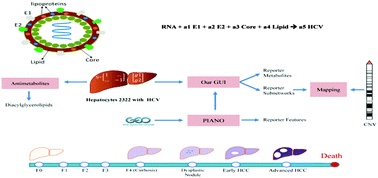Systems biology analysis of hepatitis C virus infection reveals the role of copy number increases in regions of chromosome 1q in hepatocellular carcinoma metabolism†
Abstract
Hepatitis C virus (HCV) infection is a worldwide healthcare problem; however, traditional treatment methods have failed to cure all patients, and HCV has developed resistance to new drugs. Systems biology-based analyses could play an important role in the holistic analysis of the impact of HCV on hepatocellular metabolism. Here, we integrated HCV assembly reactions with a genome-scale hepatocyte metabolic model to identify metabolic targets for HCV assembly and metabolic alterations that occur between different HCV progression states (cirrhosis, dysplastic nodule, and early and advanced hepatocellular carcinoma (HCC)) and healthy liver tissue. We found that diacylglycerolipids were essential for HCV assembly. In addition, the metabolism of keratan sulfate and chondroitin sulfate was significantly changed in the cirrhosis stage, whereas the metabolism of acyl-carnitine was significantly changed in the dysplastic nodule and early HCC stages. Our results explained the role of the upregulated expression of BCAT1, PLOD3 and six other methyltransferase genes involved in carnitine biosynthesis and S-adenosylmethionine metabolism in the early and advanced HCC stages. Moreover, GNPAT and BCAP31 expression was upregulated in the early and advanced HCC stages and could lead to increased acyl-CoA consumption. By integrating our results with copy number variation analyses, we observed that GNPAT, PPOX and five of the methyltransferase genes (ASH1L, METTL13, SMYD2, TARBP1 and SMYD3), which are all located on chromosome 1q, had increased copy numbers in the cancer samples relative to the normal samples. Finally, we confirmed our predictions with the results of metabolomics studies and proposed that inhibiting the identified targets has the potential to provide an effective treatment strategy for HCV-associated liver disorders.


 Please wait while we load your content...
Please wait while we load your content...